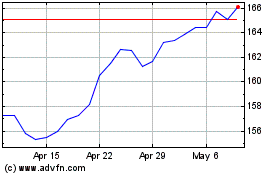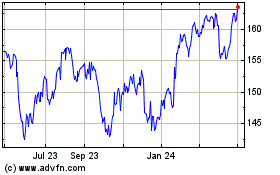Lysol Maker Is Cleaning Up, but at What Cost?
April 30 2020 - 9:47AM
Dow Jones News
By Carol Ryan
Reckitt Benckiser's portfolio of household and health brands
could have been designed for a pandemic. Keeping up with surging
demand for products such as Lysol and Harpic cleaning fluid will be
expensive, however.
On Thursday, the U.K.-based company said sales in the three
months through March increased by 13.3%, compared with the same
period of 2019. That growth was more than double what analysts were
expecting and puts Reckitt ahead of other names that are also
benefiting as nervous consumers fill up their store cupboards.
Procter & Gamble and toilet-roll maker Kimberly-Clark grew by
6% and 11%, respectively, over the same period, for instance.
Chief Executive Laxman Narasimhan, who joined Reckitt from
PepsiCo last year, has done an exceptional job given the rickety
supply chain he inherited. The company experienced a series of
mishaps in previous years after underinvestment in its factories
left production capacity too tight. While productivity is improving
at its own facilities, the company relied on third-party
manufacturers to meet last quarter's demand spike, which will
increase operating costs. Reckitt is also investing in factory
equipment sooner than planned.
The company isn't alone in this predicament: Other winners from
the current crisis, such as Amazon, Walmart and Tesco, face extra
expenses that will wipe out some of the gains from surging sales.
Unilever, which owns Lifebuoy and Dove soaps, turned to 16
third-party manufacturers in China to ramp up production for
certain brands in the early weeks of the crisis. Admittedly, lower
commodity prices will offset some of the extra costs for Reckitt,
and efficiencies will also kick in as factories narrow the ranges
they produce to maximize orders.
Like many European companies, Reckitt gives no profit numbers
alongside its first-quarter sales, so investors have to wait until
second-quarter results in July to get the bigger picture. For the
full year, the company said it would beat sales guidance given in
February, but its margin outlook is unchanged. Expectations are
high: Reckitt's stock jumped roughly 4% in European morning trading
Thursday and now trades at a full 22.4 times expected earnings --
almost as expensive as bigger, more consistent performers Nestlé
and P&G.
U.K. grocer Sainsbury shows the need for caution. The stock had
been buoyed by strong sales reports in recent weeks, but fell 5% on
Thursday after the company said extra expenses and other headwinds
would largely offset the benefit of stronger grocery sales in its
current financial year.
Reckitt is in the right places at the right time and has removed
doubts about its supply chain. The next focus will be on the
costs.
Write to Carol Ryan at carol.ryan@wsj.com
(END) Dow Jones Newswires
April 30, 2020 09:32 ET (13:32 GMT)
Copyright (c) 2020 Dow Jones & Company, Inc.
Procter and Gamble (NYSE:PG)
Historical Stock Chart
From Mar 2024 to Apr 2024

Procter and Gamble (NYSE:PG)
Historical Stock Chart
From Apr 2023 to Apr 2024
